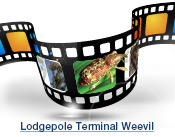| |
Weevil - Forest Health and Adaptation | |
| |
|
|
| |
|
|
| |  {GFX-ESRDx-ForestHealth-LodgepoleWeevil-Slide2.jpg}{GFX-ESRDx-ForestHealth-LodgepoleWeevil-Slide3.jpg}{GFX-ESRDx-ForestHealth-LodgepoleWeevil-Slide4.jpg}{GFX-ESRDx-ForestHealth-LodgepoleWeevil-Slide5.jpg}Lodgepole Terminal Weevil {GFX-ESRDx-ForestHealth-LodgepoleWeevil-Slide2.jpg}{GFX-ESRDx-ForestHealth-LodgepoleWeevil-Slide3.jpg}{GFX-ESRDx-ForestHealth-LodgepoleWeevil-Slide4.jpg}{GFX-ESRDx-ForestHealth-LodgepoleWeevil-Slide5.jpg}Lodgepole Terminal Weevil
Lodgepole terminal weevils (Pissodes terminalis) feed in the terminal branch, or leader, of young spruce and pine trees. Growth form is affected by feeding and the tree will likely become crooked, forked or bushy due to damage to the leader.
Lodgepole pine terminal weevils are found on lodgepole and jack pine.
Signs and Symptoms
Look for the following signs and symptoms of lodgepole terminal weevil infestation:
Crown
Leader (leading branch) only
- Adults (5 -- 9 mm long) with a long snout and mottled brown colour and white and yellow patches on the elytra (wing coverings)
- Crooked (like a Shepherd's crook) or forked (old damage)
- Curled or wilted
- Mining
- Red colour or dead
- Resin droplets
- Rows of puncture wounds/circular holes
- White grub-like larvae with reddish brown heads under bark
Similar Damage
- Can be confused with frost damage from a distance.
- Look for exit holes in the terminal and presence of larvae and/or adults.
- No chip cocoons will be found.
- This species tunnels up the leader and affects current year's growth only.
Warren Root Collar Weevil
Larvae of Warren root collar weevils (Hylobis warreni) feed on phloem in the root collar area and lateral roots of conifers.
Larval feeding may completely girdle and kill trees. This insect is capable of attacking all pine and spruce species and is found throughout Alberta.
Signs and Symptoms
Look for the following signs and symptoms of warren root collar weevil infestation:
Crown
- fading green/yellow-orange or red-brown over entire crown
Foliage/Buds
- fading green/yellow-orange or red-brown needles
Root collar / Root
- brown-black adults (12 -- 15 mm long) with snouts
- debarking/girdling
- galleries/tunnels/scoring
- presence of white grub-like larvae with reddish brown heads (18 -- 20 mm long)
- whitish encrusted resinosis at root collar
Similar Damage
- Can be confused with Armillaria root disease.
- After removing bark on root collar, look for larvae, girdling and tunnels of the phloem and cambium of the root collar.
Note: Trees attacked by root weevils can be more susceptible to Armillaria infection so it is possible to find both root weevils and Armillaria symptoms.
White Pine Weevil
White pine weevils (Pissodes strobe) feed in the terminal branch, or leader, of young spruce and pine trees. Growth form is affected by feeding and the tree will likely become crooked, forked or bushy due to damage to the leader.
This weevil is found mainly on spruce but will also feed on pine.
Signs and Symptoms
Look for the following signs and symptoms of white pine weevil infestation:
Branches/Twigs/Roots
Crown
Foliage/Buds
- Fading green/yellow-orange or red-brown needles (terminal only)
Leader (leading branch) only
- Chip cocoons
- Crooked (like a shepherd's crook) or forked (old damage)
- Curled
- Mining
- Mottled brown adults (5 -- 8 mm long) with white and yellow patches on wing coverings and a long snout
- Resin droplets
- Small circular exit holes
- White grub-like larvae with reddish brown heads under bark
- Wilted or dead
Stem / Outer Bark
- Puncture wounds/small circular exit holes (in terminal)
- Resinosis
Wood / Inner Bark
- Chip cocoons (in terminal)
- Galleries/tunnels
Similar Damage
- Also look for the presence of larvae and/or adults.
- Can be confused with frost damage from a distance.
- Look for exit holes and chip cocoons in the terminal.
- This species tunnels from the leader down, killing multiple years growth in one season.
|
|
| |
|
|
| |
For more information about the content of this document, contact Devon Belanger.
This information published to the web on February 24, 2016.
|
|